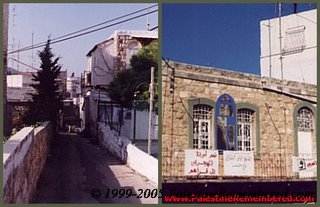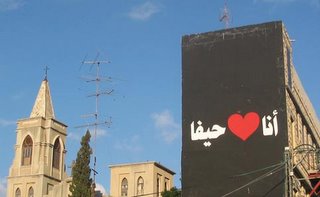Saturday, July 22, 2006
From Haifa to Marwaheen: Defenseless Refugees Abandoned


Haifa Photo: Right of Return written on sign
Photo: I Love Haifa
Haifa at the beginning of the nineteenth century was a small fishing village with a population of four thousand Palestinians. In 1869 German farmers from the Templar Society immigrated to Haifa and Jews began to immigrate in the 1880s. According to Enclyclopedia of the Palestinians, "Haifa's population grew during the Mandate from 24,634 in 1922 to some 128,000 in 1944, of whom 66,000 were Jews."
In 1948 Haifa City was ethnically cleansed of all but 3,000 of its Palestinian citizens. In addition, fifty-one villages in Haifa District were ethnically cleansed and demolished by Israel's forces.
Rabee' Sahyoun, a native of Haifa, describes the fate of his family:
"My father came from a big family who had many lands, and much influence. On the other side, my maternal grandfather worked for Barclay's Bank in Haifa. In 1948, my mother's family lost their house, the deed to which our family still holds, and became internally displaced refugees, by force of the armed units of the Israeli Haganah, and continued thereafter to suffer the consequences of being persecuted and discriminated against in their own country. My father's house was ransacked in his absence, also by the Zionist Haganah forces, and his belongings taken. Having been a famous radio broadcaster and a fervent Palestinian Nationalist, the Zionists announced that if they caught him, they would put him in a cage, cut his tongue off, and parade him through the streets for all to see. Naturally he fled under cover to Arab East Jerusalem. Those who died in the Deir Yassin massacre, in what is now part of Israeli-controlled West Jerusalem, who were paraded in the streets by David Ben-Gurion's troops before their slaughter, did not share his fortune. To this day, Sahyoun Street still exists in old Haifa, and all of our family 's lands and buildings in tact, all of which Israel gives us no right to return to or possess."
Palestinian nationalism is not dead among the Palestinian residents of Haifa. The spirit of native son Shaikh Izz al-Din al-Qassam, "patriot,social reformer,and religious teacher" who "led...the first guerilla operation of the Palestinian national movement" perseveres (Khalidi 111). Ameer Makhoul, director of Ittijah, a coalition of Arab organizations in Israel, and Haifa resident was quoted in Al-Jazeerah today: "Our lives and our hearts are in Beirut and Gaza - not in Haifa. We are part of the Palestinian nation effort and are too trying to raise our voice to tell people what is happening in Lebanon."
But what's happening in Lebanon in July 2006 is no different than what occurred in Palestine in 1948. Consider the plight of the Palestinians of Haifa. On April 22, wounded and suffering from Haganah attacks, Palestinians in Haifa sought help from the British, who rejected their pleas.
"A state of chaos prevailed as thousands of terrified Arab women and children rushed towards the port hoping to escape. But as the entire Arab area was exposed to the Jewish quarters above, the Haganah snipers killed tens of those trying to flee." Most of the expelled refugees fled to Acre, which was ethnically cleansed in a matter of weeks, and from there made their way to Lebanon, some to Tyre City and its surrounding villages. One of the villages in Tyre district is Marwaheen; one of Mawaheen's villagers is according to Robert Fisk "the child who lies like a rag doll near the charred civilian convoy, whose photograph was taken - at great risk - by an Associated Press photographer, Nasser Nasser." Her picture has become an icon.
Robert Fisk writes that the villagers fleeing Marwaheen "set off for the north in a convoy of cars which only minutes later, close to the village of Tel Harfa, were attacked by an Israeli F-16 fighter-bomber. It bombed all the cars and killed at least 20 of the civilians...." The villagers of Marwaheen had earlier appealed to the UN Battalion of Ghanaian soldiers for protection, but the defenseless villagers were rebuffed by the soldiers just as the Palestinians of Haifa were rebuffed by the British fifty-eight years earlier.
Today on CNN the mayor of Tyre, looking away in tears from the mass makeshift gravesite at El-Buss Palestinian Refugee Camp for seventy-two victims of Israel's barbarity, said that he did not know how many more bodies, unreachable, were buried beneath the rubble of the villages in southern Lebanon that Israel bombed.
Israel has no qualms about obliterating Arab presence and history. Many of Haifa's Palestinian citizens who now live in the city have been dispossessed by the Jewish state. Hanan, whose family returned to Haifa shortly after being driven out by Haganah forces came back to find her family's factory and apartment building confiscated and occupied. Israel's penchant for destruction is ongoing in Haifa. Israel's attempts to eradicate the Arab character of Haifa has included changing street names from Arabic to Hebrew and Zionist names, many named after the "heroes" of 1948.
According to Electronic Intifada, "Orders for housing demolitions are gaining momentum at a frightening pace. The Arab Association for Human Rights (HRA) recently reported that, 'On June 5, 2005 the municipality in Haifa, with the help of police forces, destroyed the home of Basim and Miriam Bushkar on Bar Yehuda Road, where the family has been living for the past 70 years.'"
Although,for the moment, the Palestine tragedy is centered in Lebanon, as well as Gaza and the West Bank, Haifa is a microcosm of the tragedy. How many of its Jewish citizens have read Emile Habibbi, one of Haifa's most famous Palestinian residents. The following story should resonate with Holocaust survivors. He writes about the Palestinian women and children who had made their way back to Haifa after expulsion, "In our alley, the search for those Arab women who had smuggled themselves in along with their children never ceased." He writes about his neighbor, a Jewish woman, Masha, who later left Haifa for Canada, who used to alert the Palestinian women and children to flee when the search parties came to their alley.
"We want to live in a city where our cultural, architectural and historical heritage is kept alive, and not been taken from us. We want equal rights, and this includes the right to our history," says one Palestinian upon a visit to Haifa.
"My father, who is old, will soon die away from the home that was taken from him, and the orchards that ran across my Mother's porch, although still ours by international law, are now enjoyed by those who made my parents refugees," writes Sahyoun.
Samia Abdenour, another dispossessed native of Haifa sums up the identification that Makhoul feels for his brethren in Gaza and Lebanon:
"Though, I thank my lucky stars for all the benedictions with which I have been endowed, yet I feel sad, angry and bitter at the injustice of life, the barbarity with which Palestinians were and are still treated, the wasted lives of the millions of dead youth, the grief of parents and widows, the inhuman state of the orphaned children, the oppression of the camp refugees. I cannot go back to my homeland, I cannot retrieve our possessions, I cannot claim our land, I cannot take my children back to Palestine to share with them my happy past and I cannot visit my father's grave in Haifa."
This much is certain. Until Palestinian rights are not relative to Jewish rights, there is no possiblity for peace. Israel is "in defiance of a wide range of international legal instruments, including numerous UN resolutions, international human rights conventions, humanitarian conventions, and bilateral and regional agreements, as well as general legal principles considered to be binding, which recognize the right of return."
Palestinians quest for equal rights is inspiring; Israelis' defense of institutionalized bigotry and its refusal to implement right of return is deadly, for Palestinians, and now, Lebanese.
Reference: Khalidi, Walid. Before Their Diaspora. Washington D.C.: Institute of Palestine Studies, 1992.






